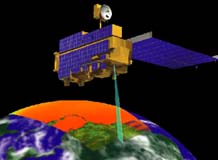| . |  |
. |
 Terra In The Clouds
Terra In The Cloudsby James E. Kloeppel Champaign - March 2, 2000 - A wealth of information on the physical properties and global distribution of clouds -- soon to be collected by a recently launched satellite called Terra -- could help scientists better predict climate change, says a University of Illinois researcher involved with the project. "Terra is the flagship of NASA's Earth Observing System Program, an international effort to monitor Earth's climate over the next 15 years," said Larry Di Girolamo, a professor of atmospheric sciences. "During the satellite's six-year lifetime, its five instruments will help scientists understand how clouds, aerosols, air pollutants, oceans, vegetation and ice cover interact with each other and impact the climate we live in." Di Girolamo's research focuses on clouds. "From a climate-modeling perspective, clouds contribute the largest uncertainty to climate change," he said. "Clouds may have a warming or cooling effect on the planet, depending on the cloud properties. Because clouds are so variable, their effect on global climate has been difficult to quantify." One of the instruments on Terra is the Multi-angle Imaging Spectro-Radiometer. MISR will be the first instrument to make global, high-resolution, multi-angle, multi-spectral radiometric measurements of Earth from space. The instrument will characterize cloud, aerosol and surface properties in a manner no other satellite has been capable of. "It's MISR's ability to look at the same scene from different angles at a high resolution that makes MISR so unique," Di Girolamo said. "You get a lot more information about an object when you look at it from different angles than you do when you look at it from a single angle." Unlike traditional meteorological satellites that have only one camera, MISR has nine cameras that will successively view portions of the planet in four spectral bands. "By combining spectral and angular signatures, we can gather more information about atmospheric or surface features than spectral signatures alone," Di Girolamo said. "The use of multiple cameras also permits stereoscopic imaging, allowing us to look at clouds in 3-D." Di Girolamo has been involved with the MISR project for the past decade. As a graduate student, he worked on new techniques for studying clouds from multi-angle data, which helped set the instrument specifications. More recently, he developed the cloud-detection and classification algorithms that will process the complex data needed to better understand the role that clouds play in Earth's climate system.
Read On For A Climatic Week At TerraDaily
Related Sites This Article
|
| |||||||||
| The content herein, unless otherwise known to be public domain, are Copyright 1995-2016 - Space Media Network. All websites are published in Australia and are solely subject to Australian law and governed by Fair Use principals for news reporting and research purposes. AFP, UPI and IANS news wire stories are copyright Agence France-Presse, United Press International and Indo-Asia News Service. ESA news reports are copyright European Space Agency. All NASA sourced material is public domain. Additional copyrights may apply in whole or part to other bona fide parties. Advertising does not imply endorsement, agreement or approval of any opinions, statements or information provided by Space Media Network on any Web page published or hosted by Space Media Network. Privacy Statement All images and articles appearing on Space Media Network have been edited or digitally altered in some way. Any requests to remove copyright material will be acted upon in a timely and appropriate manner. Any attempt to extort money from Space Media Network will be ignored and reported to Australian Law Enforcement Agencies as a potential case of financial fraud involving the use of a telephonic carriage device or postal service. |